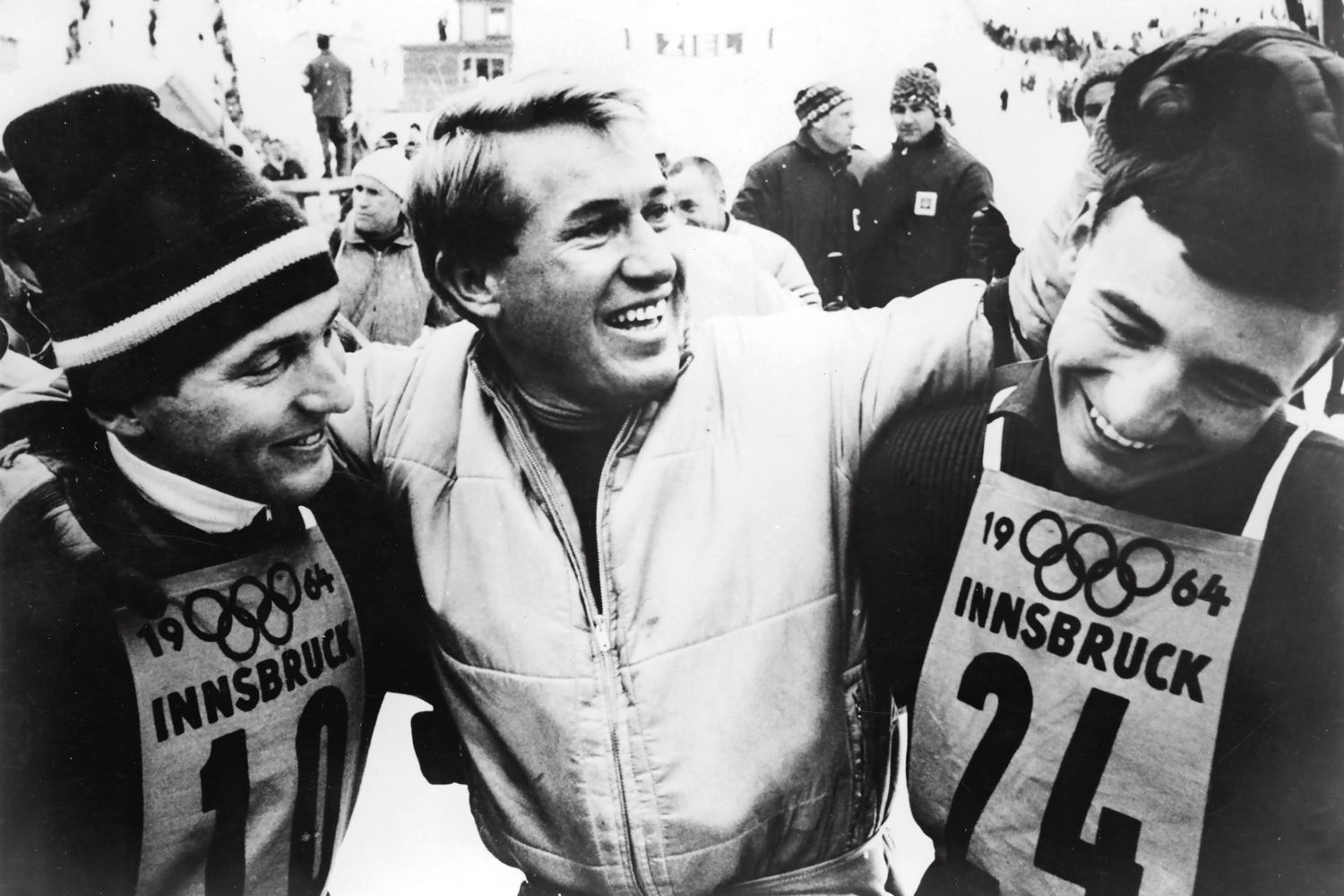
The 43 Skilebrities Who Put Aspen on the Map
Image above: Bob Beattie, center, with Billy Kidd and Jimmie Heuga at the 1964 Olympics in Innsbruck. Courtesy Aspen Historical Society
Urban Dictionary defines “skilebrity” as “a famous pro skier who is really well known. A combination of skier and celebrity.” While it’s a nice, pat explanation, we wanted to broaden the definition when thinking about who in Aspen has had, or continues to have, a lasting impact on Alpine skiing and snowboarding. That’s because ever since the 1930s, when skiing’s US pioneers explored the local Elk Mountains for their snow-sliding potential, many of the sport’s influencers and innovators—athletes, coaches, instructors, inventors, and industry bigwigs—have come from Aspen or gravitated to this area. These pages tell the story of Aspen as a ski town—and American skiing history—through some of our most accomplished characters.
The 1930s–1950s
Klaus Obermeyer
If there’s one person to credit for making skiing more comfortable and enjoyable, it’s Obermeyer. Born in Bavaria and trained as an aeronautical engineer, this visionary first manifested his DIY attitude at age 3, when he made a pair of skis from orange-crate boards.
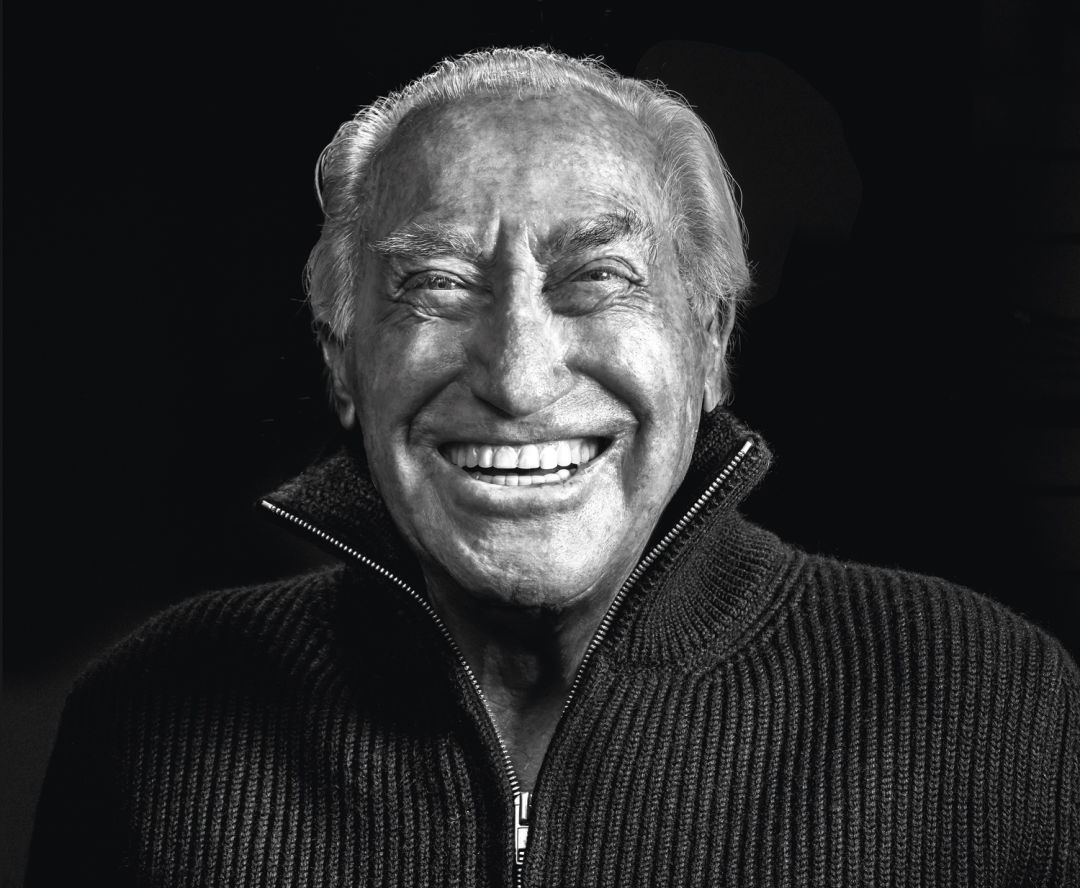
Klaus Obermeyer, October 2019
Image: Karl Wolfgang
Arriving in Aspen in 1947 to teach skiing, Obermeyer has since channeled his desire to share his love of the sport into some of its most innovative accoutrements. First was the down parka. Thinking that his clients would spend more time on the slopes if they could keep warm during long, chilling chairlift rides, Obermeyer fashioned a prototype from the duvet his mother had given him and sold it to actor Gary Cooper.
At a time when people skied mostly in street clothes, Obermeyer’s inventions were revolutionary. His first ski turtleneck, for example, was made from Egyptian cotton, felt like silk, and had a seamless collar. When ski instruction took a backseat to product development, he launched Sport Obermeyer in 1961, and more firsts followed: waterproof, breathable outerwear; a nylon windshirt; and soft-shell jackets, to name a few.
In terms of equipment, Obermeyer created double-pronged ski brakes and initiated several improvements in ski-boot comfort and performance: the first double boot; a narrower-heeled last; and the liquid-injected Flow Boot, which molded to one’s feet—his only patented invention (because, he says, “instead of protecting what you did, the theory was to always look forward and make it better and better again”). No point of comfort escaped Obermeyer, who also foiled the harmful effects of Colorado’s sunshine with the first mirrored sunglasses and high-altitude sunscreen.
“Skiing is such a beautiful sport,” says Obermeyer, who—in likely another first for the ski industry—still runs his company as he approaches 100 (his birthday is Dec 2). “To be outdoors in the beautiful landscape of winter, the primary thing was to make the sport better, safer, nicer, and more fun. Skiing makes winter fun!”
Dick and Miggs Durrance
He was America’s first skiing star, plus a pioneering ski photographer and filmmaker. She, no slouch on skis either, documented Aspen’s rise as a ski resort with her own camera, in between traveling the world shooting for Time, Life, Sports Illustrated, and National Geographic magazines.
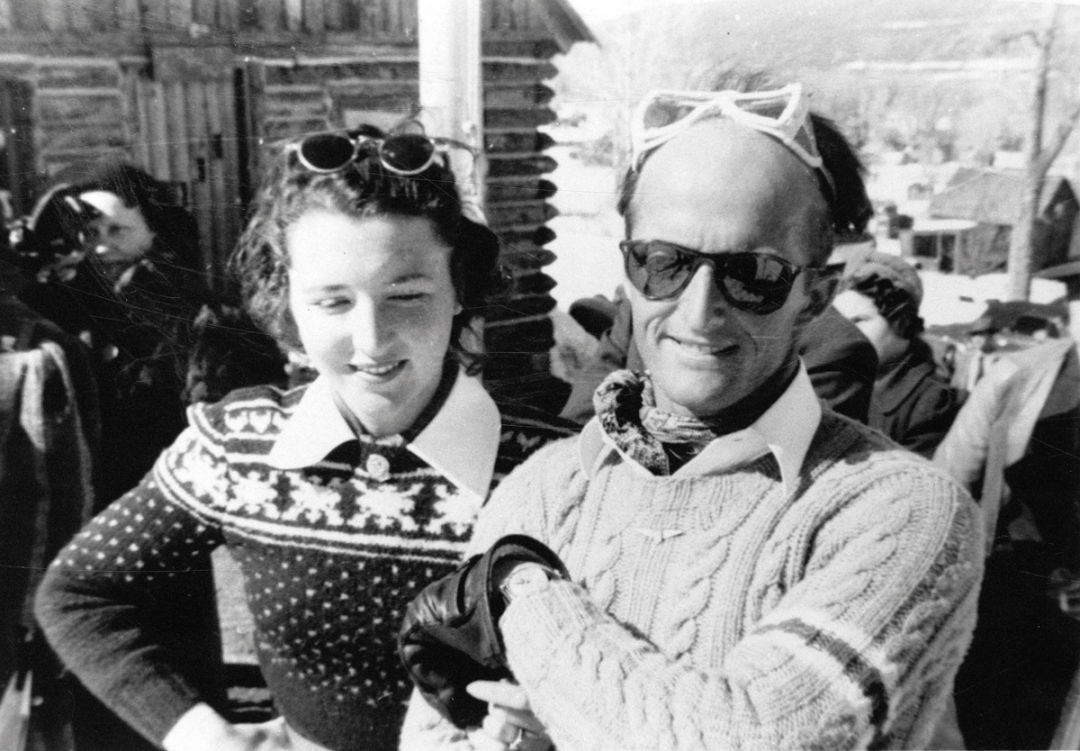
Miggs and Dick Durrance
Together, the Durrances were the power couple of early American and Aspen ski history. They met in Sun Valley, Idaho, both making the 1940 US Olympic ski team (she as an alternate), but they didn’t compete when the Games were canceled. Instead, during World War II they helped develop and manage Alta, in Utah, and designed and tested skis for a Denver company. In 1947, Dick took the helm of Aspen’s fledgling resort company.
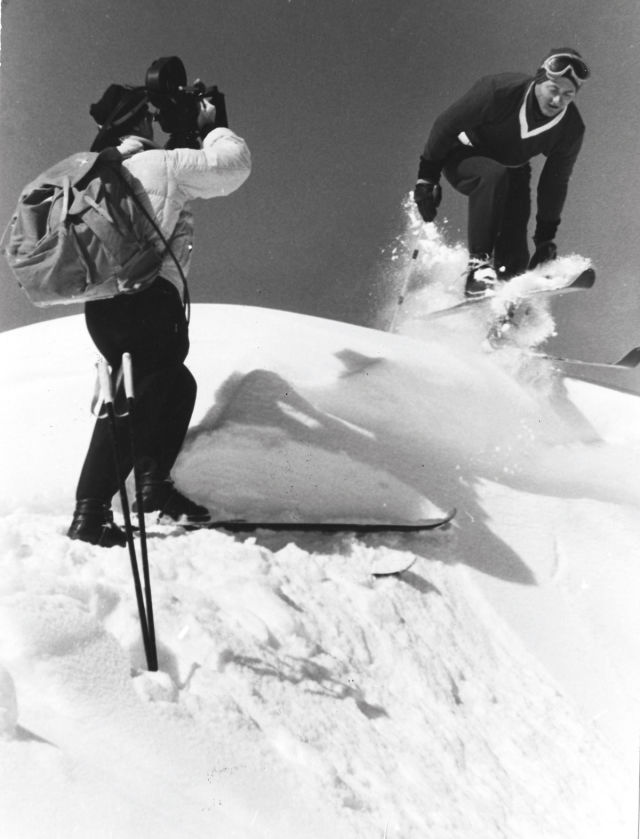
Dick Durrance filming Bill Mason in 1955
With 17 national titles and one Winter Olympics (1936) under his belt, Dick knew ski racing. He’s credited for bringing the 1950 World Championships to Aspen—the first held outside of Europe—consequently boosting the fortunes of the town and the struggling ski mountain.
Photography was Dick and Miggs’s common bond. He taught her how to shoot him skiing for promotional photos for Alta and proposed to her in the darkroom. Although Miggs’s photography career arguably surpassed her husband’s—Dick split his focus with documentary films, around 45 total—their combined legacy, comprising tens of thousands of images, tells the story of Aspen over five decades.
Other Praiseworthy Peeps
Elizabeth Paepcke first visited Aspen on a ski trip in 1939, then convinced her husband, Walter, to check out the unspoiled haven. The rest is history.
•
Pioneering Swiss mountaineer André Roch designed Aspen Mountain’s first ski trail—Roch Run—to host ski races and co-created the town’s first ski club.
•
10th Mountain Division veteran Friedl Pfeifer co-founded Aspen’s first ski school, the Aspen Ski Corporation, the Roch Cup ski races, and (with Art Pfister) Buttermilk.
•
US Ski and Snowboard Hall of Famer Fred Iselin earned a devoted following running the Aspen, Aspen Highlands, and Buttermilk ski schools, and through his best-selling book, Invitation to Skiing.
•
Austrian ski racer Elli Iselin also designed skiwear and opened town’s first ski clothing boutique, Elli’s of Aspen.
•
Son of an Aspen mining pioneer, DRC Brown leased claims on Aspen Mountain to the Aspen Ski Corp, then grew the business as an investor, board member, and the president for 22 years.
•
The namesake of Ruthie’s Run on Aspen Mountain, Ruthie Brown helped start the BOLD program for blind skiers and America’s first Outward Bound courses.
•
Thanks to the persistence of 30-year Aspen Ski Club race secretary Ruth Whyte, the Roch Cup is engraved with the winners of local World Cup races, creating a historical record on America’s longest-running ski trophy.
•
Whip Jones opened Aspen Highlands in 1958, bringing a streak of irreverence with hot dog contests and local-friendly pass prices.
The 1960s–1980s
Stein Eriksen
Skiing’s first superstar, a freestyle pioneer, and one of the sport’s best ambassadors, Eriksen helped draw attention to startup ski areas in Aspen and Snowmass at the height of his career.
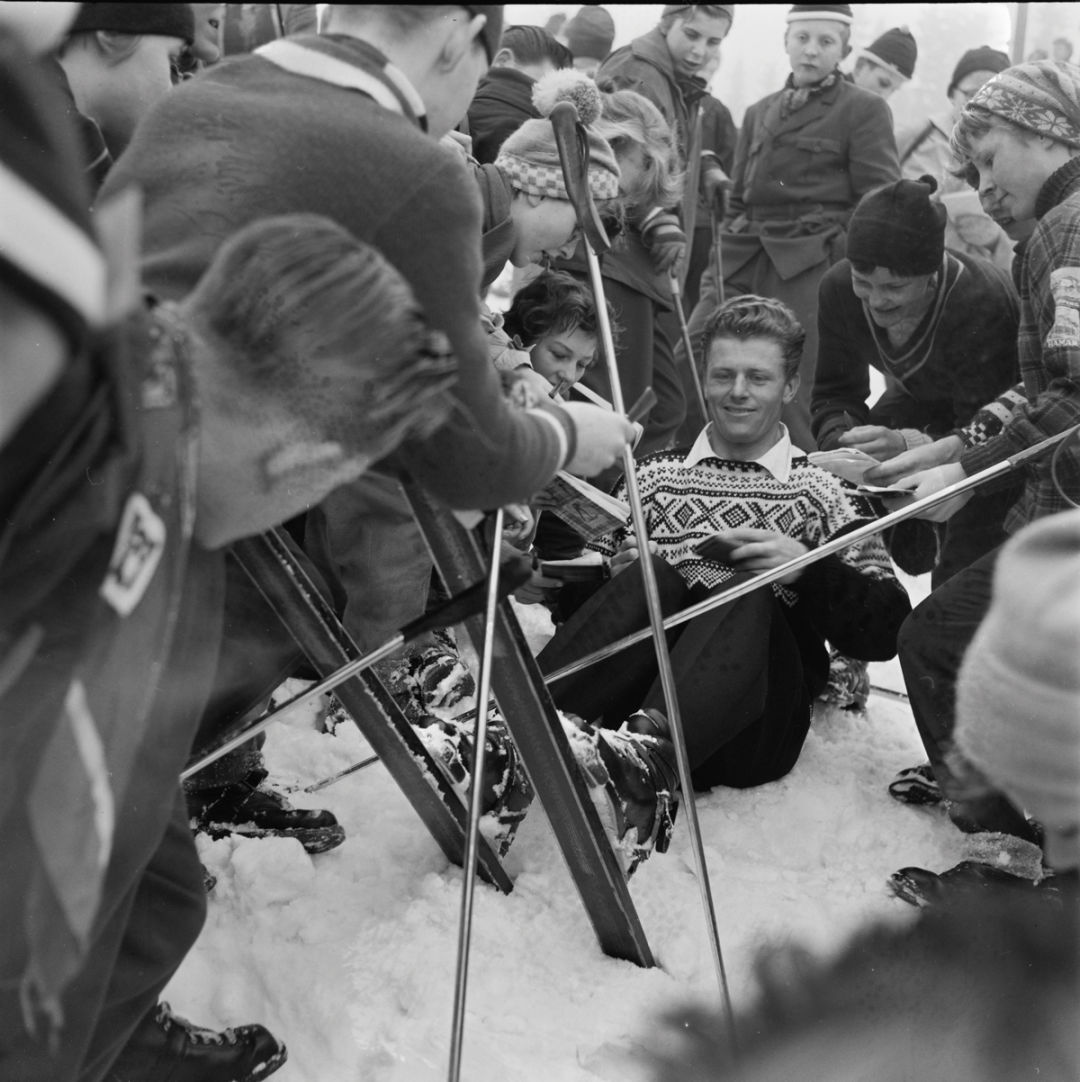
Stein Eriksen signs autographs in Norway in 1954.
Image: Wikimedia Commons
He won several ski-racing gold medals for Norway and placed third in slalom at the 1950 World Championships in Aspen, before moving permanently to the United States in the mid-1950s.
Aspen Highlands founder Whip Jones brought back Eriksen, then ski school director at Heavenly Valley, to help lay out ski trails and run the ski school, then credited him with helping achieve 30,000 skier visits in the resort’s first season. Everyone wanted to “ski like Stein.” He also drew crowds during his regular on-snow aerial displays.
In 1967, Eriksen was lured back again, this time from Sugarbush, to become Snowmass’s founding ski school director. With charismatic flair, on opening weekend he jumped through a paper-covered hoop, his coterie of Norwegian instructors skiing in unison behind him.
Eriksen left Snowmass for Park City and ended his long ski-ambassador career in Deer Valley. But his eponymous ski shop, other business interests, and many friends drew him back to Aspen often, and the affectionately dubbed “Norwegian mafia” continued Eriksen’s style of teaching and socializing at Snowmass for decades.
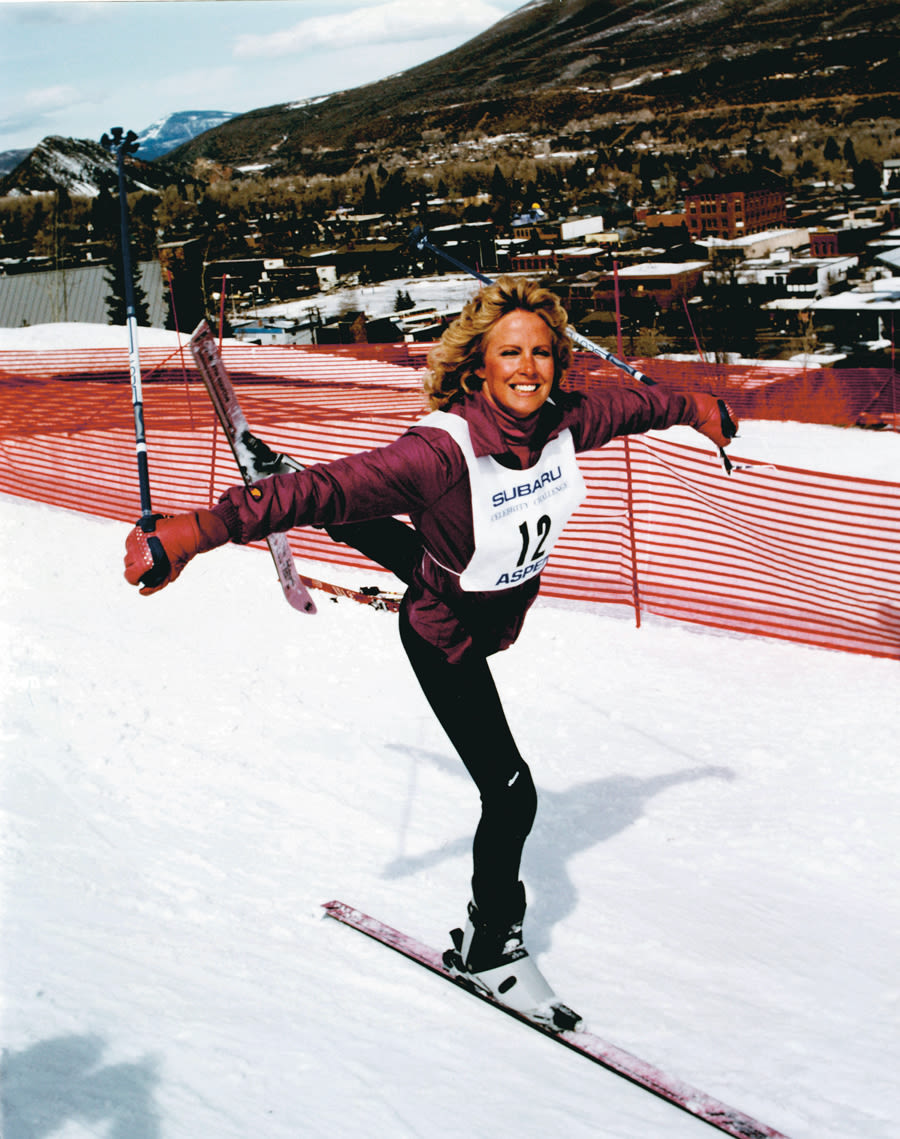
Suzy Chaffee skis at the 1980 Subaru Celebrity Classic in Aspen.
Captain of the 1968 US women’s Olympic ski team, Alpine racer, and three-time world champ in ski ballet, Suzy Chaffee later figured out how to leverage her fame—remember the Suzy ChapStick ads?—for social good.
The US Olympic Committee’s first female board member, she advocated for Title IX, which mandates equal opportunity for girls and women in sports. Chaffee also pushed for making freestyle skiing an Olympic sport (after kickstarting its women’s division) and, more recently, champions Native American opportunities through snow sports, including while she lived in Aspen from 2000 to 2004.
Aspen native Bill Marolt, a 1964 Olympian, coached the University of Colorado (CU) ski team to seven consecutive NCAA titles, then turned his golden touch to the US Alpine ski team, which earned a record five medals at the 1984 Olympics. After a stint as CU athletic director, Marolt returned to lead the national team—now the US Ski and Snowboard Association—for 18 years. During his two tenures, US snow sports athletes won an impressive 70 Olympic medals. Marolt was also a 12-year VP of the International Ski Federation and now serves on the board of the US Olympic and Paralympic Committee.
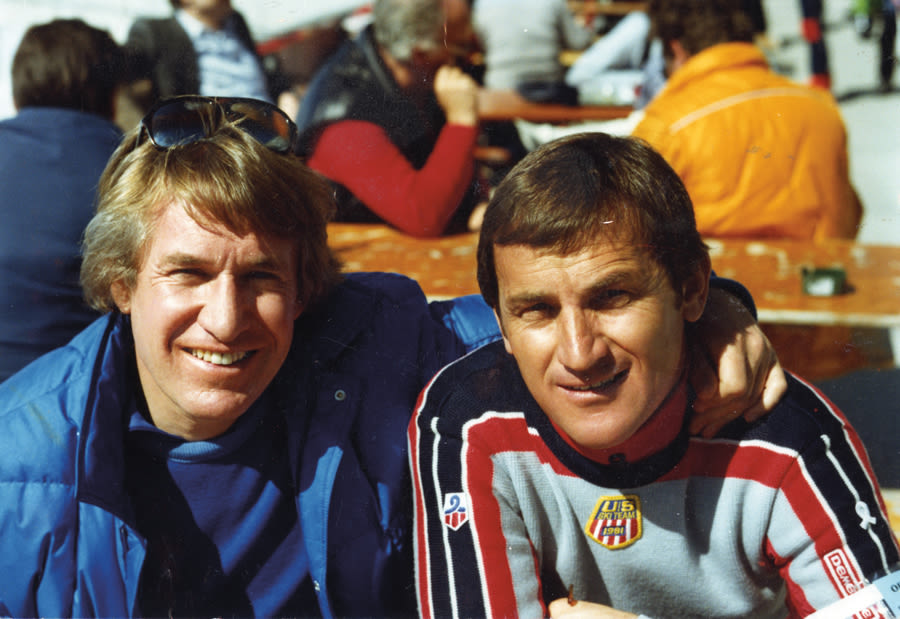
Bob Beattie and Bill Marolt at a ski race in 1981, when Beattie was an ABC commentator and Marolt coached the US Ski Team
Bob Beattie successfully coached collegiate skiers before becoming the first national ski team coach in 1961. He co-founded ski racing’s World Cup, tying disparate competitions into one of sports’ most notable international tours. In 1970, Beattie, by then a TV commentator, moved to Aspen and launched the World Pro Ski Tour, which ushered in a golden era for racing.
A lifelong promoter of skiing, Beattie shepherded NASTAR into the world’s most popular public ski program and co-founded an Aspen club program that serves kids regardless of finances. His final push: successfully incorporating dual-slalom races into the World Cup circuit.
Other Praiseworthy Peeps
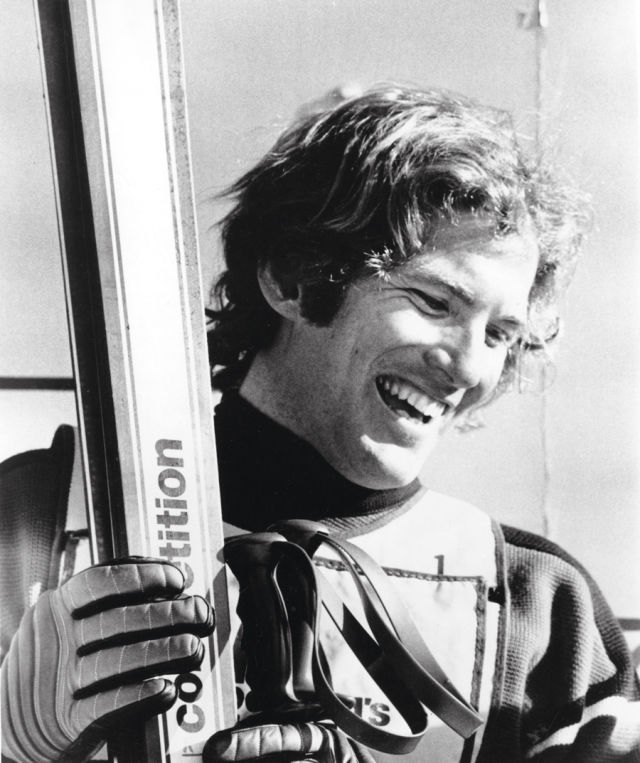
Spider Sabich in 1976
American ski-racing hunk Spider Sabich is more notorious for getting shot and killed by girlfriend Claudine Longet in their Aspen mansion than for his multiple on-snow accomplishments, including two pro-tour championships.
•
Aspen High and Ski Club alum Andy Mill was at one time America’s best downhiller, placing sixth in the 1976 Olympics, then hosted Ski with Andy Mill, among other TV gigs.
•
Curt Chase organized Aspen Mountain’s first ski patrol, led its ski school for 17 years, and helped found the Professional Ski Instructors of America.
•
Andrea Mead Lawrence’s record of two Alpine skiing gold medals in a single Olympics (1952) still stands, while a 1960s stint on Aspen’s planning board spurred a career in environmental activism.
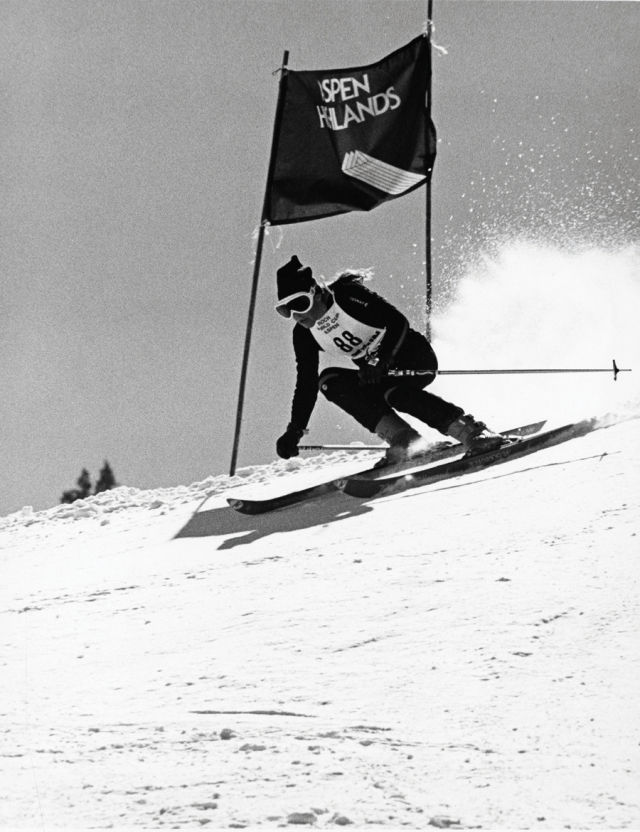
Christin Cooper races at Aspen Highlands.
The voice of women’s ski racing for 30 years and 1984 Olympic giant slalom silver medalist Christin Cooper splits her time between Aspen and Montana with husband (and former racer) Mark Taché.
•
For more than 40 years, four-time Swiss national ski champ Stefan Kaelin and his wife sold high-fashion European skiwear at his eponymous Aspen shop.
•
Fifth-generation Aspenite Dave Stapleton was a national ski team and pro racer—and son of the town’s first World Cup official—before running Stapleton Sports for 17 years.
•
In addition to growing NASTAR for 30 years, Aspen native Bill Madsen (sister Beth was a 1988 Olympian) skied in five Warren Miller films and as a stunt double in Aspen Extreme.
•
Former ski racer and developer Bill Janss bought up ranches in the Brush Creek Valley, then, with the Aspen Ski Corp, opened Snowmass in 1969 as the first ski-in, ski-out US resort.
The 1990s–Today
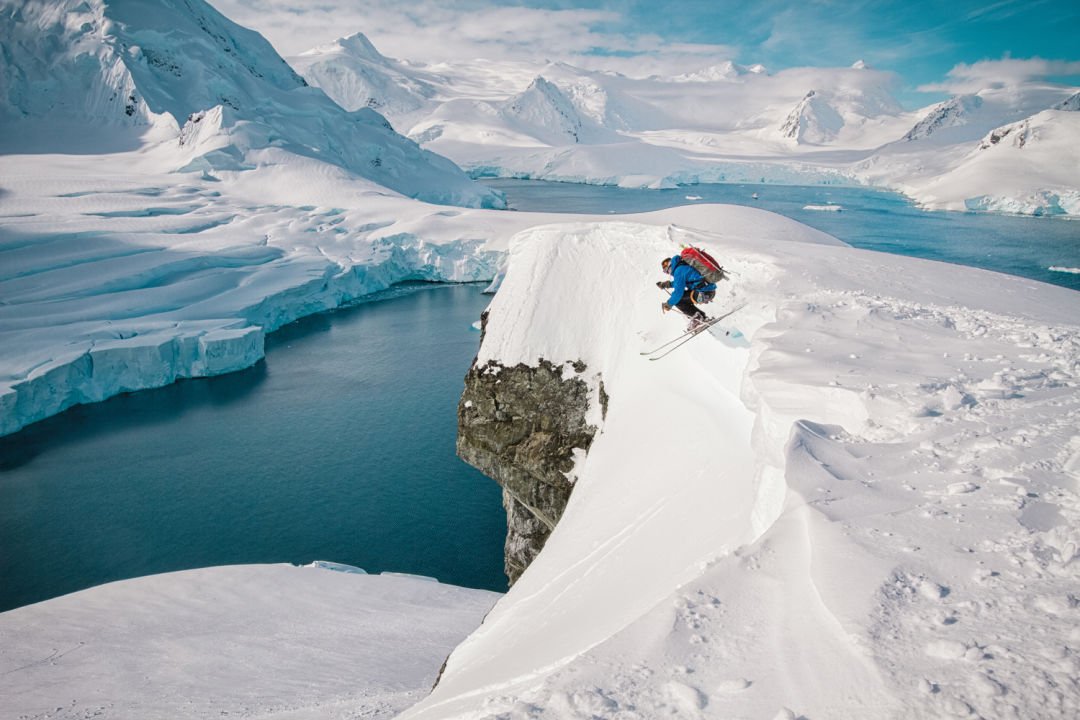
Chris Davenport hucks a cornice in Antarctica.
Image: Jim Harris
One of the world’s most accomplished big-mountain skiers and ski mountaineers, longtime local Chris Davenport also calls ski races, has more than 30 ski-film credits, and gives presentations around the world, all of which make him one of Aspen’s best brand ambassadors. The US Ski and Snowboard Hall of Famer also uses his wide-ranging voice to advocate for climate action as a board member of Protect Our Winters.
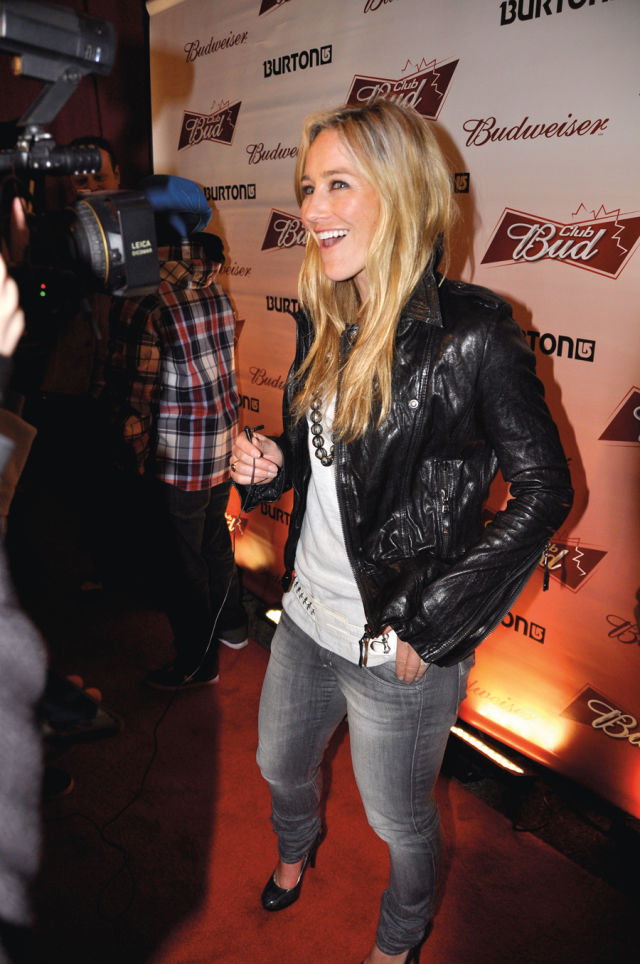
Gretchen Bleiler during the 2010 Olympics in Vancouver
Image: Wikimedia Commons
Half-pipe snowboarder Gretchen Bleiler, who grew up in Snowmass Village, was one of our first local X Games medalists, winning gold in 2003. With a 15-year career that included four more X Games medals and an Olympic silver, she also earned the ESPY Award for Best Female Sports Athlete and a National Geographic Adventurer of the Year honor. Bleiler has since translated her skills into business—most notably, her sustainable water bottle company, ALEX—and climate activism, including lobbying on Capitol Hill.
As a youth, Mac Smith used to poach powder at Aspen Highlands. For the past 40 years, he’s been managing it. Thanks to his intimate knowledge of the mountain and passion for sharing steep and deep terrain, the longtime patrol director has been the driving force behind opening Steeplechase, Highland Bowl, and Deep Temerity—and, consequently, Highlands’ outsize reputation for extreme skiing.
Katie Ertl started teaching skiing to put herself through college; now she’s Aspen Skiing Company’s senior vice president of mountain operations and one of the highest-ranked women in the ski industry. Other notable gigs include the first female manager of the Professional Ski Instructors of America’s National Team and Bryce Kellogg’s stunt double in Aspen Extreme. Ertl also managed the Highlands and overall Aspen Snowmass ski schools before attaining her current position in 2017.
Other Praiseworthy Peeps
Aspen ski instructor Ivan Petkov conceived the shaped ski in 1992, selling 1,200 pairs of his patented S Skis in two years.
•
Olympic pentathlete and former ski coach Sven Coomer designed breakthrough innovations for ski boot companies before striking out on his own and moving to Aspen—your feet can thank him for custom orthotics, Zipfit liners, and the heated boot bag.
•
Half-pipe skiers and best friends Alex Ferreira and Torin Yater-Wallace grew up together in Aspen Valley Ski & Snowboard Club’s (AVSC) freestyle program. Ferreira has garnered Olympic silver and five X Games podiums, while Yater-Wallace, who graced a Wheaties box after earning X Games silver at age 15, racked up several more medals despite debilitating medical setbacks.
•
Carbondale native and four-time X Games medalist Peter Olenick, the first half-pipe skier to land a double flip in competition, currently coaches South Korea’s freestyle ski team.
•
Aspen ski club alum Johno McBride has notched 20-plus years coaching Canadian and American speed skiers—including Bode Miller and Daron Rahlves—and now serves as AVSC’s Alpine director.
•
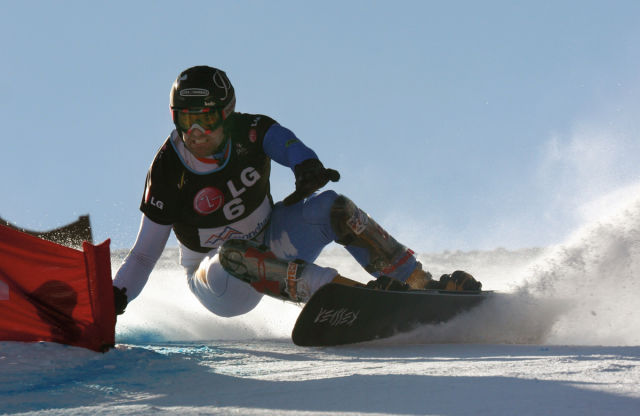
Chris Klug at a World Cup race in Telluride in 2010
Image: Wikimedia Commons
The only transplant recipient to compete in the Olympics, Aspenite Chris Klug won snowboard giant slalom bronze in 2002—18 months after a liver transplant.
•
One of the country’s most sought-after ski instructors is Aspen Mountain–based John Clendenin, a two-time freestyle skiing champion in the 1970s who helps intermediates move past their plateaus.
•
Perhaps the only World Cup racer to belong to a ski gang, Wiley Maple skis with “the Freaks” on Aspen Mountain when he’s not racing downhills.
•
Aspen Center for Environmental Studies’ Development Director Christy Mahon, the only woman to ski Colorado’s 100 highest peaks, is now tackling the next 100.
•
Former US Ski Teamer, two-time World Extreme Skiing champion, and all-around legend Kim Reichhelm offers clinics and guided trips around the world, including at her Aspen home base.
•
First-year US Ski Team member and Aspen native Bridger Gile, now 20, hiked Highland Bowl, skied in two Warren Miller movies, and won NASTAR’s national championships twice in his age group—all before finishing kindergarten.
•
One of the most decorated American adaptive skiers ever, Laurie Stephens, an eight-year local resident, has seven Paralympic and 13 World Championship medals.
•
Former Aspen Skiing Company CEO Pat O’Donnell pioneered green initiatives in the ski industry, including the first resort sustainability department, employee-run environment foundation, and significant renewable energy use.














































